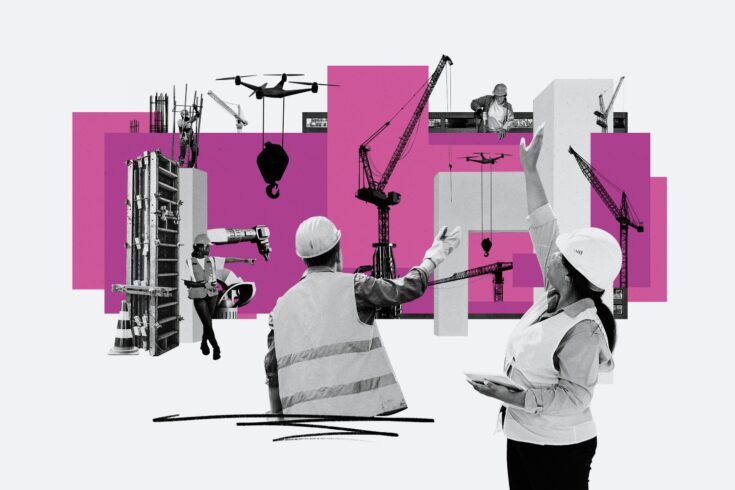The quality of our offices, factories, airports, roads and railways has a major impact on UK economic productivity. Almost half of our GDP is supported by sectors that rely on this built infrastructure, but the methods used to build it hadn’t changed much in decades.
Productivity in the construction sector was lagging the rest of the economy by around 15%, putting at risk delivery of UK infrastructure such as new schools and hospitals. Something had to change.
In 2017, as the then head of urban systems, I was asked to write the business case for what would become ‘Transforming Construction’ as part of the cross-UKRI Industrial Strategy Challenge Fund.
I have a background in research and development and in developing successful innovation strategies. However, I’m not from the construction sector, so listened carefully to a wide pool of industry specialists.
New approaches were needed
What became clear was the sector knew what it needed to do to transform but was missing the important catalyst of funding to trial new approaches on builds and to share risk in working with sectors with solutions, such as manufacturing and digital.
This of course is what Innovate UK does: removes the barriers to innovating faster by bringing all the parts of a future economy together.
We also worked with our colleagues in the Engineering and Physical Sciences Research Council (EPSRC) on critical research to get buildings to net zero, and with the Economic and Social Research Council (ESRC) to ensure the sector had access to the best current economic and social science knowledge.
A clear picture emerged when we consulted academics and industry pioneers in construction, manufacturing, energy and digital.
Cheapness was the dominant measure
The system of producing buildings had evolved into one in which how cheap you made it dominated over the value it delivered.
This meant not only that the economic benefit of built infrastructure was sub-optimal, it was also affecting how we provided societal benefits such as health.
With government keen to do things differently, particularly departments providing schools and hospitals, we positioned the scope to be principally about buildings.
We had to make better buildings
We realised we had to focus not just on making buildings in a better way, but to make better buildings. We would focus on three things.
The first was adopting digital manufacturing processes to produce buildings in a more consistent and repeatable way. The old approach relied heavily on coordinating skilled workers on site. Moving more work into factories and improving processes on site increased quality, safety, and productivity.
Second, was to change how buildings were procured so that value was prioritised over cheapness. Whole-life running costs (rather than just capital build), environmental impact and how well a building did what it was designed for came first.
The third was to meet net zero commitments at the lowest cost. Buildings are a load on the energy system but integrating renewable energy technology in a building can flip it to be an active part of the grid. It can generate, store, and manage its own energy.
Meeting our targets for change
Not coming from a construction background was an advantage in shaping the case. I was able to write it free from sector jargon so that it could be understood by the aligned sectors we wanted to collaborate with.
We also gained strong buy-in from government with a clear case explaining the wider benefit.
We set stretch targets to deliver construction projects 50% faster and at a third of the whole-life cost. We also aimed to eliminate the 15% productivity gap with the rest of the economy.
We expected the industrialised approach could cut the carbon emissions associated with building materials and construction by half, and emissions during use of the building to zero.
As the transforming construction challenge closed in 2022 all these targets were met on real buildings.
Construction research and development isn’t easy. Trying something new on a building is risky. You still have to sell the building or you go out of business. The challenge funding meant new approaches could be trialled and their impact measured.
Working together on new rules and standards
The shift to a whole new way of working for the sector meant collaborating on the rules and standards and competing on delivery.
We funded the Construction Innovation Hub to bring the sector together to develop common processes, along with the assurance and digital tools needed to make these standard practices.
The hub also worked to embed its Value Toolkit and Platform Rulebook into the Construction Playbook: new guidance on the way government procures buildings.
We funded the Active Building Centre, which has shown that net zero can be achieved for essentially the same overall cost as a traditionally-built, less energy-efficient building.
Construction had to overcome the myths
My biggest learning along the way was that the construction sector has held itself back.
It wasn’t recognising its role in improving life for everyone by focusing on the value buildings provide. Automating the repetitive parts of the construction process using standardised, digitally managed approaches that work in manufacturing frees up the focus to do this.
Prioritising cheapness didn’t work for anyone. To really accelerate a transformation, we had to help the sector overcome the myths that were stopping change.
We worked on a change narrative (essentially the business case strategy rewritten as a story) and used it to align every story we told about the numerous investments we had made.
These stories added up to a better narrative than the one the sector held, and we have watched as this new, more compelling story has replaced the old one.
Storytelling makes powerful case for change
Lessons from the challenge are being applied on over £14 billion of projects to date, making a real difference to people’s lives. More broadly, evidence suggests that on average £1 of public R&D investment generates at least £7 of net benefit to the UK.
It means better schools where teachers and pupils concentrate longer in more pleasant teaching environments. Better hospitals where patients recover faster due to more calming surroundings. Better homes that are healthier and net zero with virtually no energy bills.
For me, it has demonstrated the power of storytelling to not only explain the case for change and the opportunities for innovation but also provide a compelling vision of the future. This is something I’m taking on into other work across UKRI.
Top image: Credit: UKRI




